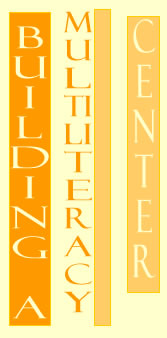

Course
Support
KHM: To give a more specific idea of how the Multiliteracy Center
worked to support individual courses, can you talk about an innovative
or challenging project that involved the Multiliteracy Center working
with a course?
DS:
Well, one of the ones I like to talk about is a project that we worked
on during our very first semester of operation, which was with an instructor,
George Cooper, who routinely teaches a section of freshman writing, English
125, through the Michigan Community Scholars Program. As the name implies,
the Michigan Community Scholars Program focuses on service-learning and
community-oriented learning. The course
that we came up with as part of this program was a service-learning approach
in which students would create websites for non-profit organizations.
George and I worked together to identify two non-profit organizations
that needed a website, and we asked the freshmen who were enrolled in
the course to work in two groups to collaboratively produce these websites
for the non-profit organizations. And, at various points throughout the
semester, the representatives from the non-profit groups would come to
the class and speak to the students about their groups and about the services
their groups provided.
KHM: So, you helped the instructor to design the course so that students would write for a real world audience -- in this case, the non-profits?
DS: Right. The non-profit groups themselves were a real world audience and the people who the non-profit groups aimed to serve were an audience. The non-profit groups were almost a kind of client that contracted with the students to come up with a functional composition, a functional website, that would serve their needs.
One of the groups was called HERO. HERO focuses on the homeless and provides a number of services for homeless people. The other group is named COURSE and focuses on urban development and planning and adopts a kind of new urbanism philosophy. So, representatives of those groups would come in throughout the semester and do almost mini-seminars with the students and talk to the students about what the organization does and what they'd hope to achieve by a website. And then the students would develop those websites.
KHM: And were the non-profit organizations' expectations met at the end of the course by what the students had produced?
DS:
Yes. The end goal was to have students produce websites that would be
usable by the non-profit groups, and I think, by and large, that goal
was met in both cases. A version of the sites that the students created,
is actually being used by COURSE.
The site that HERO uses will be, by and large, the site that the students
designed with a few modifications. So, yes, I think, by and large, it
was successful.
Top | Next